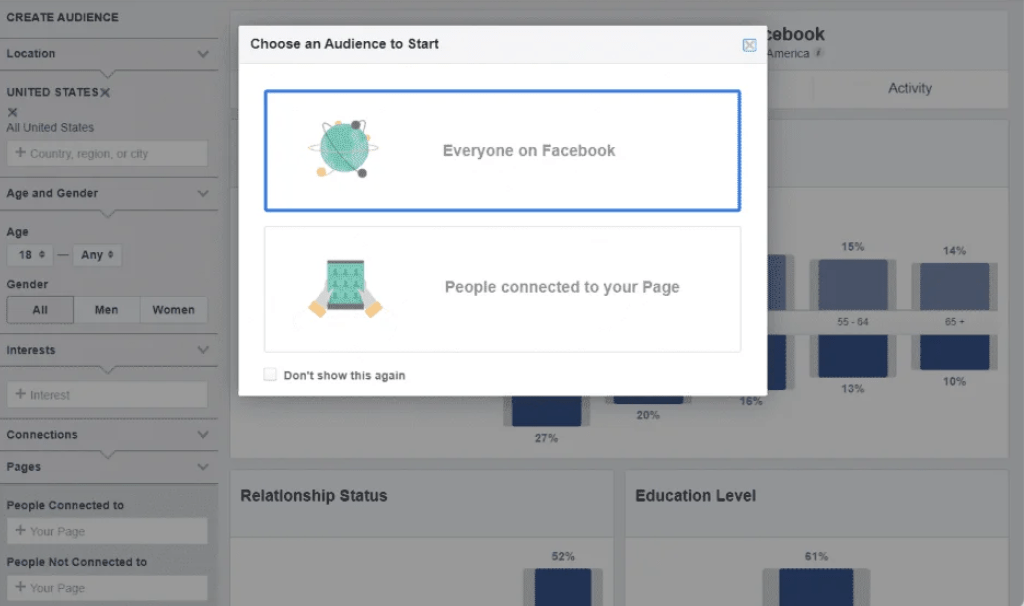A target market is a specific group of people that you want to reach through your marketing campaign. These people are more likely to visit your online shop and make a purchase than any other random group of people. They have certain characteristics in common, such as demographics, and psychological and behavioural patterns. It helps to have an appreciation of the psychology of ecommerce.
When you zoom in on this market segment at the individual level, you have your ideal customer. The type of customer that you don’t have to convince to buy your products or services because he or she will naturally be interested in them. All you have to do is get your brand name and online store in front of your eyes.
So, in effect, your target market is your target audience.
And that’s where your target market analysis will begin, with your ideal customer, so don’t be afraid to be super specific when identifying your target customer.
That’s not to say that other individual consumers outside of this group won’t buy your products. They can.
However, identifying your target audience is all about creating an effective marketing strategy so that your marketing dollars have the biggest bang for their buck. And that happens when your marketing campaign reaches the people who are MOST likely to make a purchase.
How to conduct audience research
To clearly understand your target audience, you need to first do a little bit of investigation. By understanding who your products and services are for, and how to find them, you’ll be able to create a marketing strategy that makes you money.
1. First, understand your niche market
Whatever it is that you’re selling, it’s most valuable to a very specific set of people. This is a nice market.
To understand your niche, take a look at what you’re selling and why you’re selling it. This will help you understand not only what you have to offer but also why your potential customers will want to buy it.
Ask yourself:
- What need does your product or service satisfy?
- Does your product or service solve any pain points or problems in your target customer’s life?
- What are the benefits of purchasing your product or service? How does it improve your potential customer’s life?
Whenever you get bogged down in the details of your target market analysis, come back to the answers to these questions. Let them be your guiding light through your research.
2. Look at your existing customers
If you’re already turning a profit in your business, then that means that you already have direct access to your target audience. After all, your current customers have already made a purchase with you, so you know for a fact that they convert.
Once you understand your existing customer base, you can target more people like them with your marketing plan.
Take a closer look at your customer base and see if you can identify any patterns in their characteristics, such as demographic or psychographic characteristics like
- Age – What is the general age range of your current customers? Knowing this data will help you when choosing your target segment in social media ads.
- Gender – Are your current customers mostly male or female? This will help you better understand their specific needs and wants that are perhaps unique to their gender.
- Income – How much money do your customers have to spend on your products or services? Are they able to make repeat purchases or do they need to save up for your product? Are there any financial barriers that you need to address?
- Location – Where do your customers live and what time zone are they in? What are some cultural issues that are unique to their location (ie products targeting American football versus real football
- Behaviour – How do your customers hang out online? Which pages or brands do they follow and what is their preferred social media platform? What kinds of content do they consume and can you incorporate that into your content marketing strategy?
- Lifestyle – How do your customers spend their free time? What kinds of products or services do they need to support those hobbies?
- Values – What are their general beliefs and values? Does this influence their brand loyalty, where they purchase products, or what kinds of products they purchase?
You can learn a lot of this information by studying your Google Analytics or social media analytics, which I’ll cover in a second.
In B2C, you should be building and enriching your customer data, for example by scanning business cards into whatever CRM you’re using. To do that you can use dedicated software, such as ScanToSalesforce, ScanBizCards or Eight.
For any data points that aren’t included in these reports, feel free to create a free (and very brief) survey that you can send to customers post-purchase. Pair the survey with a discount code so that your customers are motivated to complete the survey and possibly return to your store for more shopping.
3. Look at your analytics
When you place ads or create a digital marketing strategy, it’s important to know precisely what kind of content to share and where to share it. You can easily know this by looking at what kind of content currently brings customers to your online shop and which content converts to a sale.
A lot of the information you want to know is readily available in the analytics dashboard of your website or social media pages.
- Google Analytics guide
- Facebook analytics guide
- Twitter analytics guide
- Pinterest analytics guide
- Instagram analytics guide
- YouTube analytics guide
When you dig into the data, you’ll be able to understand your audience based on four segmentation types:
- Demographic Profiles– This market includes attributes like age, gender, ethnicity, religion, location, income, education, etc. It may seem like super dry information (it is) but it will help you tremendously when you are creating your ads.
- Geographic Profiles – This data refers to where your target audience lives and informs you when choosing your posting schedule on social media, sending email marketing campaigns, or talking about regionally specific topics. It also helps you understand where to place your ads and when.
- Behavioural Profiles – Behavioural looks at purchasing behaviour, occasion-based behaviour, the usage rate of your products, purchase reasoning, customer loyalty, and how they interact with your brand. Understanding these data points will help you understand what exactly motivates people to purchase your products.
- Psychographic Profiles – Psychographic data reveals what beliefs, values, attitudes, interests, or lifestyle factors may influence a person’s shopping behaviour.
Market segmentation sounds like a lot of technical details, but it’s just a way to place super-efficient ads. This way, your marketing effort isn’t wasted on anybody who is not likely to purchase your products.
But remember the ultimate of segmentation is personalisation. Segmentation is marketing marginalisation. Hyper-personalisation outperforms segmentation 20:1, so either run alongside your email service provider or run hyper-personalisation software instead. The worst thing you could do is not run it at all, you might as well throw in the towel now.
4. Look at your competition
If you don’t already have an existing customer base (or even if you do), then checking out what your competitors are doing will help you understand your customer profile.
Snoop around their website, blog, social media pages, and ads to see if you can understand their target market strategy. As you investigate, ask yourself these questions
- Can you identify their tactics?
- Who is their ideal customer?
- Do they have a specific target market or multiple target markets? What is it/are they and why?
- How do they promote their products? What kind of language do they use? What product features do they highlight?
- What is their posting schedule? How often do they post or send emails?
Get to know your competitors as if you’re their customer base. Sign up for their newsletters and follow their social media pages so that you can see, first-hand, what it’s like to be their customer. Then take notes. To dive deeper into how to create a social media strategy may help, as would knowing how to create a competitor analysis.
5. Understand your product features and benefits
When you’re doing your target audience analysis, you want to take the time to understand exactly what motivates potential customers to purchase your products.
This comes after you’ve figured out who your target audience is and before you start making efforts to reach your target audience. The idea is to catch them in the decision-making process when they’re still trying to decide whether or not they want to make a purchase.
The way to do that is to show them how your products or services can directly benefit them and improve their daily lives.
Many marketers talk about this in terms of product features versus product benefits. The product feature is what the product is or does. The benefit is the result and how it affects your potential customers.

Cool, but how does that benefit the target customer?

This product helps you store your fruits and veggies while also keeping them fresher for longer, saving you both money and time.
By showing potential customers how they will benefit from your product, they are more likely to make a purchase…
…making your marketing efforts worthwhile.
If you aren’t already clear about what your product benefits are, then it’s time to make a list. Go through the top products that you intend to share through ads on Facebook and Instagram and write out exactly how each product will benefit those who buy it.
Not only will this process help you with selling your products, but it will also help you with identifying your target audience.
As in the case with The Swag, the product helps keep fruits and veggies fresher for longer. Their target audience likely eats fruits and veggies in their home-cooked meals, meaning that they are likely generally healthy and concerned with food waste.
By understanding how your products improve the lives of your customers, you are better understanding your target customers.
6. Test paid ads on your target market
Now that you’ve completed your audience analysis and have a good idea of who your ideal customer is, it’s time to start running ads.
Though search engine optimization is by far the best marketing strategy with the highest ROI, running ads gives you quick gains and lots of data to work with.
Facebook Ads Manager allows you to easily run ads on both Facebook and Instagram. And if you don’t know where to begin with placing ads, you can first check out Audience Insights to compare your audience analysis to real-life Facebook users.

To get started, create a custom audience according to your analysis, then create different versions of ads for the same product.
Alternatively, you can use the same ad on different audiences that you create through the custom audience feature.
Spend just about $5 per ad set just to see how users respond, whether they click your ads or even purchase your products.
The idea is to test out your ads and audiences until you find exactly the right combination that brings you the most conversion (sales).
Use this testing process regularly and with each new product that you intend to place ads for. And, when necessary, do another audience analysis to ensure that you are reaching the right people in your marketing efforts.
Target market examples
Let’s take a look at some major brands that have killed it in their target market analysis. They have found their ideal customers far and wide by being super specific and targeted.
1. Nike Target Market
Nike sells apparel, equipment, shoes, and accessories to athletes and people who play sports. Their products are good quality and last for a long time, driving the price range up enough so that only people with disposable income can afford to purchase their products.
But that’s not the only detail about their target audience.
They specifically target young aspiring athletes and runners, two groups of people who rely on motivation to continue pushing themselves beyond their normal limitations.
And we can see this play out in most of Nike’s marketing campaigns, where they create motivational ads that can move viewers to tears.
2. Netflix Target Market
A lesson to be learned from Netflix has less to do with its actual target market, which is constantly evolving, and more to do with its approach to reaching its target market.
They continuously research their audience and meticulously provide them with what they want. From mail-in DVD rentals to a behemoth online streaming service, Netflix has notoriously leaned into its audience and pivoted when needed.
And in doing so, they let word-of-mouth marketing, fuel their sales.
3. Lego Target Market
Lego is a household brand across the entire world and for good reason: though children are the users of their products, parents are the ones buying them.
So Lego built its entire marketing strategy around appeasing the parents. Not only that but Lego also partnered with brands, movies, and video games with cult-like followings to further secure its place in the fantasy world that many children escape to.
By understanding their target audience and potential barriers to purchase, Lego turned itself into a multi-billion dollar business.
4. Vans Target Market
Vans has made its empire by appealing to misfits and rebels. Like Netflix, the company learned to lean into what worked and who wanted their products rather than trying to strictly stick to their original vision. By allowing the target market to guide them, they found extreme success with their loyal customers.
5. Dior Target Market
Dior is an exclusive brand that sets itself apart with its high price tag and innovative design. By setting itself apart with such a niche brand, it very easily found its very niche audience.
But it wasn’t their unique value proposition that made them super successful. It was the way they marketed themselves as exclusive that did the trick.
By understanding what kinds of people would appreciate their products, they made their marketing campaigns to match.
6. Coachella Target Market
Coachella is a music festival that hosts artists of all genres, proving to be the festival where everyone is welcome.
And the hipsters, who pride themselves in being a unique carbon copy of everything cool, ate that offering right up. As the primary market for the Coachella festival, hipsters paved the way for the Coachella marketing campaign.
The brand started pairing up with other brands that hipsters regularly interact with, such as H&M and YouTube, to further solidify their place in the hearts of hipster millennials, eventually making themselves a multi-million dollar annual festival.
Hyper-personalise your email marketing
Roughly 70% of ecommerce sales happen because you have provoked the consumer into action, instead of waiting for them to come to your site. Therefore those who only hyper-personalise web content will perpetually suffer from lethargy, compared to those who go and hold the hand of their customers, and lead them gently in, namely email market hyper-personalised product selections for them.
But while email has remained the largest provocation source for so long, IT has moved on, as has the AI it uses. Now the power of email marketing is truly vested in the personalisation, not of peripheral elements that ESPs try to confuse and gas-light you about. But you should be focused on personalised product selection – which smashes AOV, for every individual consumer you have. In turn, this leads to massive customer lifetime value and decimates your rate of return of goods.
Imagine knowing every customer, like you do your best friend. Hyper-personalisation distinctions are many, companies like SwiftERM, deliver such significant growth through hyper-personalised email relevancy, perpetually delivering exactly the products that each individual wants to buy at the precise moment. It is verified by many highly acclaimed global research companies around the world, as delivering 20 times the volume sales, and ROI, over those not using it.
It’s time to get started if you haven’t
As an ecommerce founder, identifying your target audience will give you a clearer direction on how to position yourself. Things like your brand voice, and your brand story, come in handy because you already know who you’re reaching out to. The same goes for any other marketing channel that you’re hoping to work with — referral marketing, you need to properly segment your customers. For influencer marketing, there’s no point in reaching out to new moms when you’re looking to sell pet food (right?)





